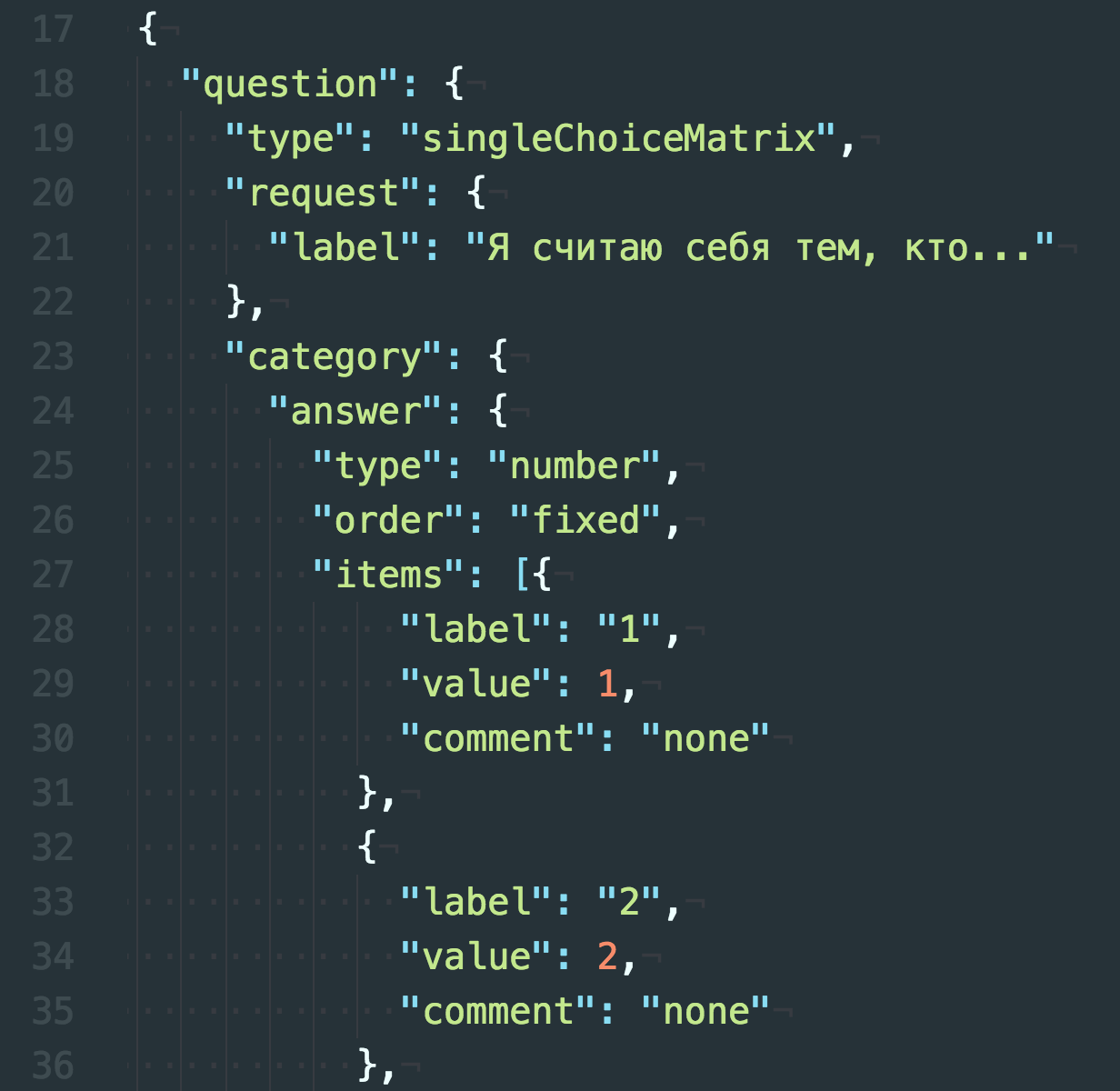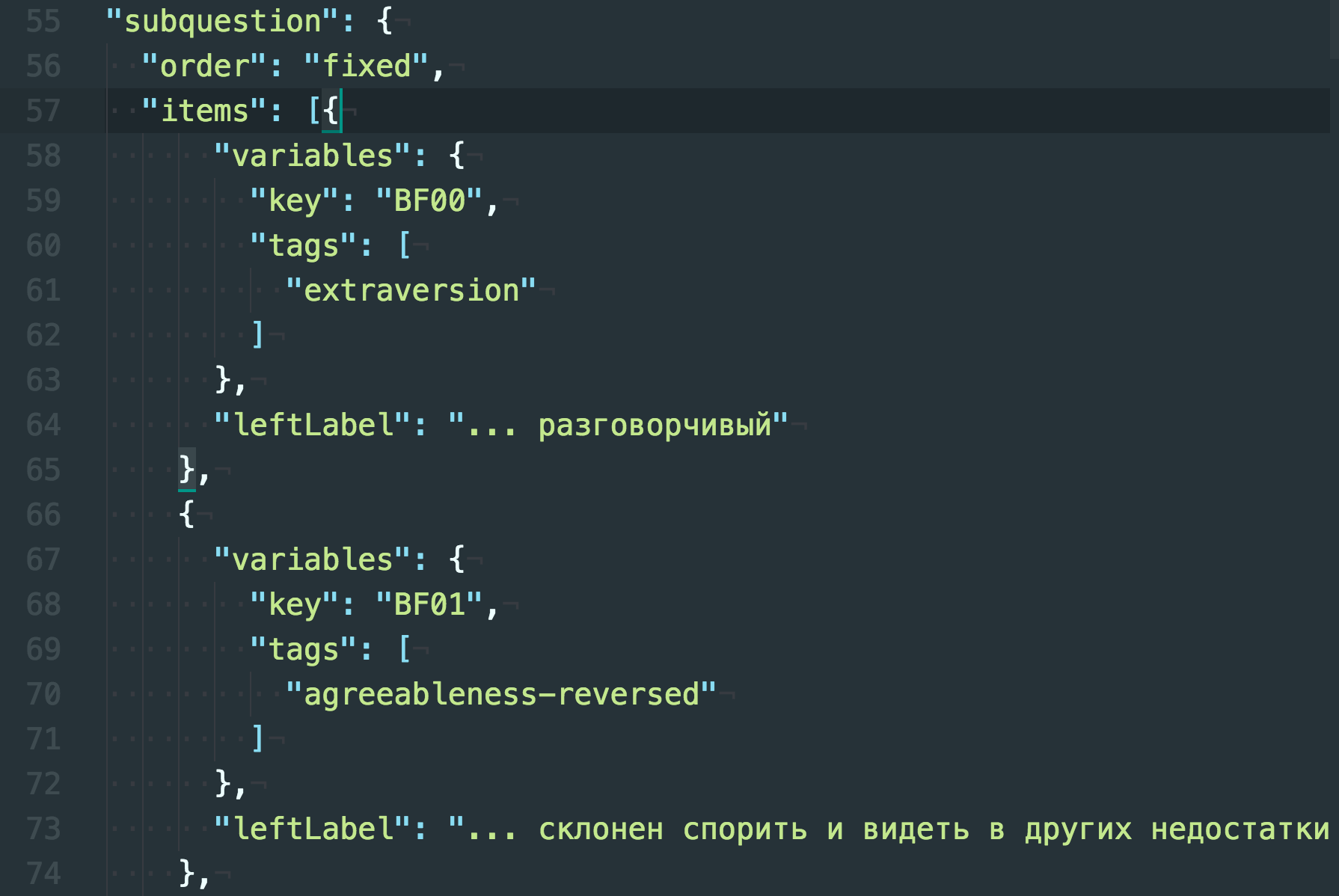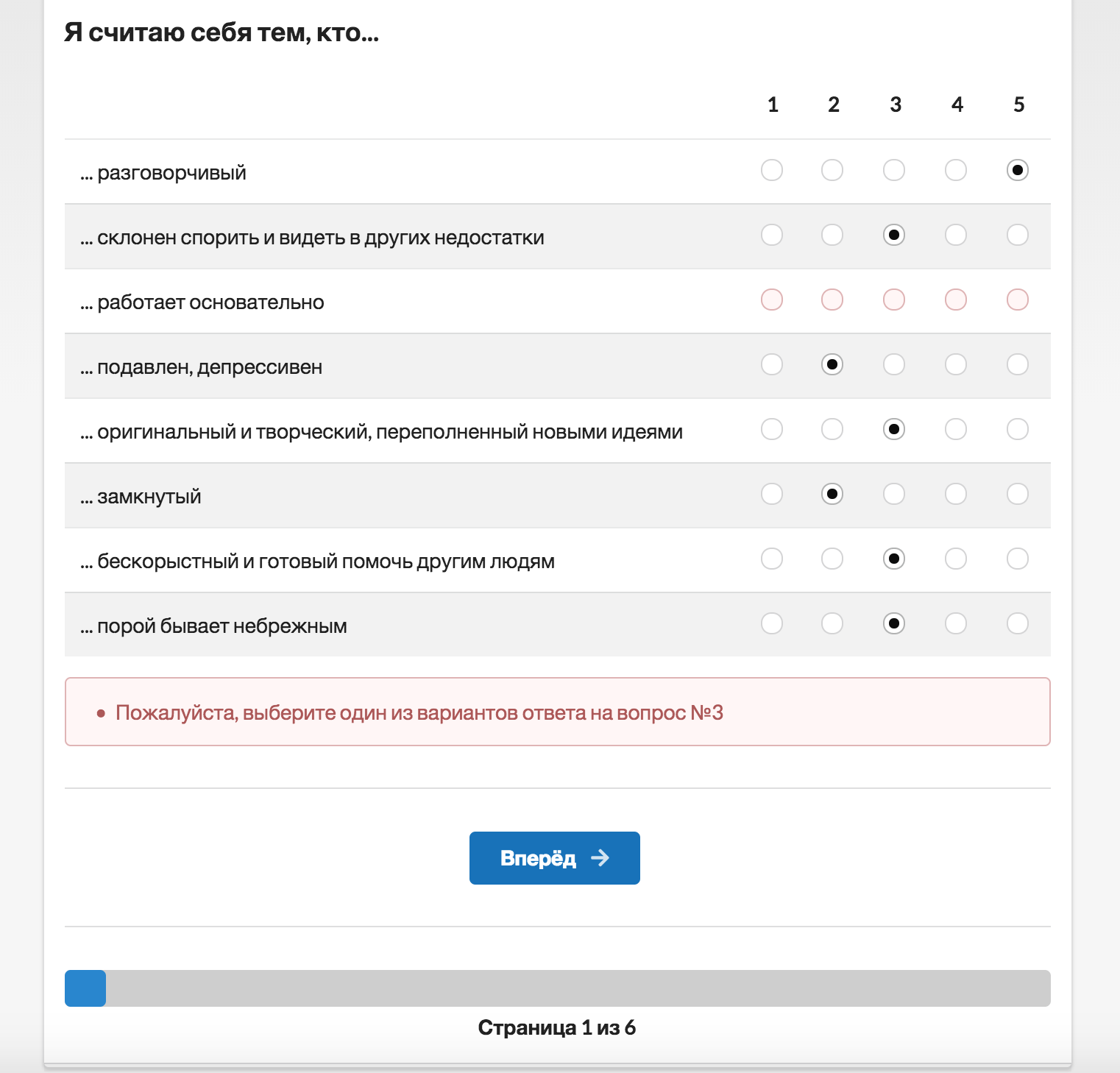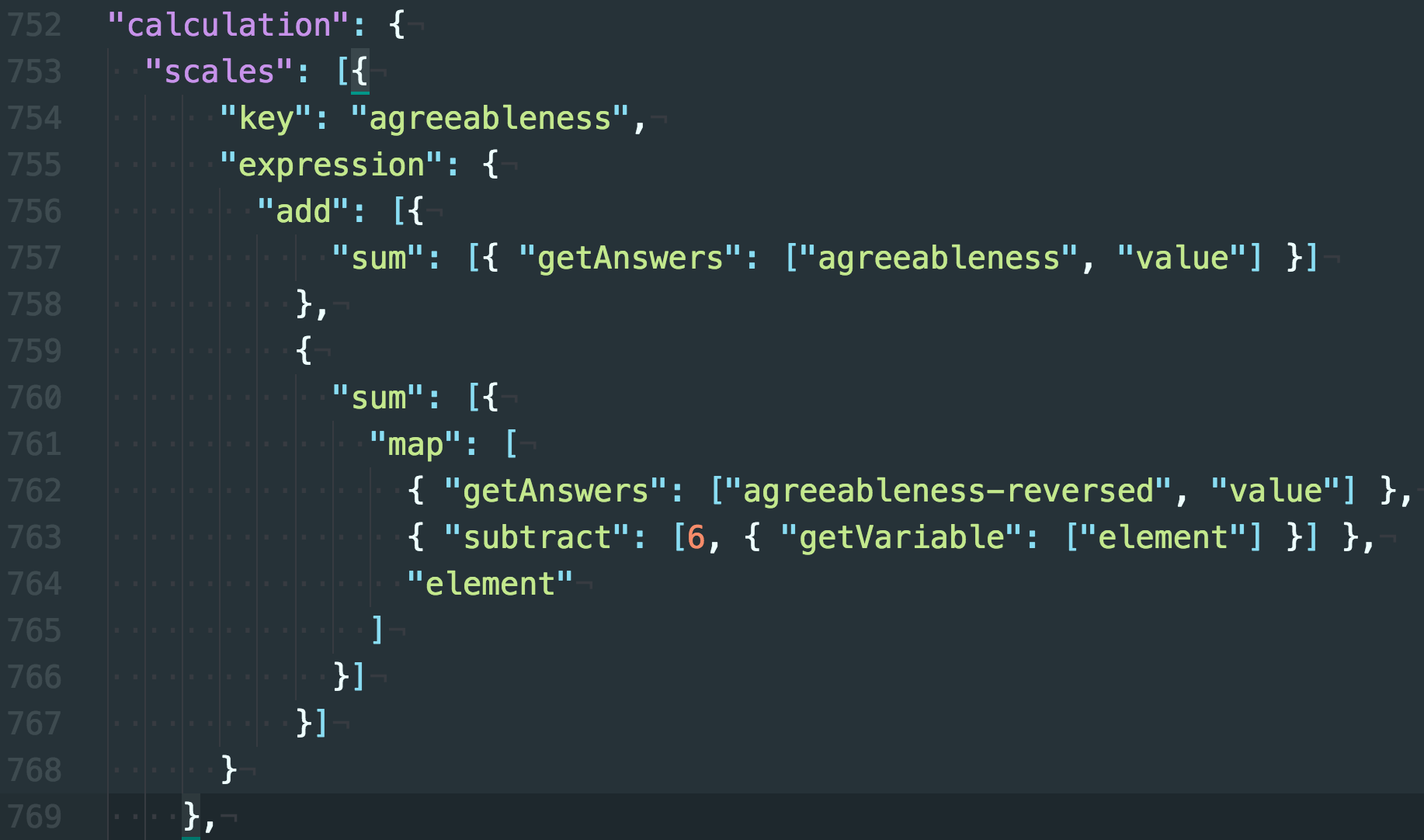Abstract
The paper studies the possibility of Big Five technique implementation using questionnaires standard for the web-based platform. It is noted that the use of online tools for research in the field of psychology is becoming more relevant. Therefore, an experiment was set up. In this experiment, the technique was described in the JSON format for the use in web-based platform. The resulting file includes both elements of questionnaires and algorithms of scale values calculating. All 44 questions were marked with tags (5 tags for direct and 5 tags for reverse calculating). The aim of the study is checking if tests’ format matches allotted tasks (support of questionnaire organization, scales values calculating) and search for possible disadvantages of defined format. The result suggested that the Big Five technique implementation is possible in the defined format, but it is advisable to supplement embedded domain-oriented language with functions that are related to the subject area directly.
Keywords: Psychology researchweb-based platformbig fiveJSON Schemadomain-specific language
Introduction
Automated tools are used more often for the pursuance of the research in the field of psychology (Gosling & Mason, 2015; Zhou & Fishbach, 2016). There are a number of online services that offer research tools in the form of questionnaires (e.g., Survey Monkey, Qualtrics, LimeSurvey, EnKlikAnketa). One of these services was described in the following papers: Zakharov, Nikulchev, Ilin, Ismatullina, & Fenin, 2017; Nikulchev, Ilin, Kolyasnikov, Kasatonov, & Zakharov, 2017. It is suggested to use a single format for questionnaires description (Nikulchev, Ilin, Kolyasnikov, Ismatullina, & Zakharov, 2018). It is claimed that two main components (presentation of questionnaire to the subject and test results calculation) are encapsulated in a single file.
Many techniques that can be used in format of online-tests are known. The authors decided to set up an experiment to implement the Big Five technique (John & Srivastava, 1999) in a declared format because of its wide application in the research community (McAdams & Pals, 2006).
Problem Statement
The previously declared data format of psychological tests should be checked to see if it could be used for the Big Five technique implementation as one of the most common.
As a toolkit, the technologies described in the study (Nikulchev et al., 2018) were used: semistructured JSON data format with the limitations described in the JSON Schema format (Pezoa, Reutter, Suarez, Ugarte, & Vrgoč, 2016), and web-based platform tools (Nikulchev et al., 2018) for technique presentation.
Research Questions
The paper studies following two questions:
Q1: whether the data format provides the necessary elements for the Big Five questionnaire organizing?
Q2: whether the data format provides necessary tools for scales values calculating used in the Big Five technique?
Purpose of the Study
The aim of the study is checking if tests’ format matches allotted tasks (support of questionnaire organization, scales values calculating) and search for possible disadvantages of defined format.
Research Methods
The authors set up an experiment to implement the Big Five test using the defined format. For the purpose, questions were numbered (from BF00 to BF43 - 44 questions) and divided into some groups that were assigned with tags. These tags correspond with direct and reverse calculation of scales values. Therefore, the test file contains 5 scales and 10 tags. The distribution of questions by tags and scales is presented in Table
Result calculation algorithm was identical for each of scales. It can be described in the following way.
There are two vectors. The first one is the vector of the answers with the direct weight A. This vector contains
,
where
Findings
The implementation can be divided into two components:
Questionnaire presentation to the subject;
Questionnaire results calculation.
The first component also includes the aspects responsible for test passing (e.g., the time limit, the presence of the questions that require an answer). In this case, there is no time limit but all questions require answers.
Questionnaire implementation.
The singleChoiceMatrix question type was used for test implementation. Each of tests contains five answers identical for every question (Figure

Matrix rows are implemented as subquestions and contains independent keys, by which the results are accessible. Tags are used to combine questions on five characteristics. According to Table

Every question in the technique is require to answer. So “Hard reminder” mode was set up. For a better perception, the question were divided into groups of 8 questions (and 4 questions in the last group). The instructions for the test were duplicated on every page. Figure

It is necessary to note that visualization is different for mobile devices, because the width of mobile screens does not allow displaying questions in the table form. It may be deduced from the foregoing that the suggested standard questionnaires are sufficient to implement the Big Five tests.
Implementation of scale values calculation.
Many tags are necessary to calculate answer results with the direct and reverse calculation type. The scale values calculating rules are prepared in accord with the calculation formula and in web-based platform proposed declarative domain-oriented language. An example is shown in Figure

It means that embedded domain-oriented language is sufficient for the Big Five questionnaire results calculation. It is advisable to supplement this language with domain-specific function to increase the code readability and to speed up test implementation.
Conclusion
The paper studied the possibility of the Big Five technique implementation with the use of defined format and the corresponding tools. The authors set up an experiment in which both questions Q1 and Q2 were answered positively. The standard of the questionnaire is sufficient for the Big Five test and similar in the tests’ structure. The functions’ list of the embedded domain-oriented language meets the specified requirements, but it is worth noting that it is advisable to supplement it with functions that relate directly to the subject domain.
Acknowledgments
The work was carried out within the framework of the state task of the Ministry of Education and Science, project No. 25.13253.2018/12.1 “Development of the technological concept of the data center of interdisciplinary research in education”.
References
- Gosling, S. D., & Mason, W. (2015). Internet research in psychology. Annual review of psychology, 66, 877-902. doi: 10.1146/annurev-psych-010814-015321
- John, O. P., & Srivastava, S. (1999). The Big Five Trait taxonomy: History, measurement, and theoretical perspectives. In L. A. Pervin & O. P. John (Eds.), Handbook of personality: Theory and research (pp. 102-138). New York: Guilford Press.
- McAdams, D. P., & Pals, J. L. (2006). A new big five: Fundamental principles for an integrative science of personality. American psychologist, 61(3), 204-217
- Nikulchev, E., Ilin, D., Kolyasnikov, P., Ismatullina, V., & Zakharov, I. (2018). Development of a Common Format of Questionnaire Tests for a Web-based Platform of Population and Experimental Psychological Research. ITM Web of Conferences, 18, 04004.
- Nikulchev, E., Ilin, D., Kolyasnikov, P., Kasatonov, S., & Zakharov, I. (2017). Evaluation Of Nosql Dbms Scalability For Storing Data For Psychology Web Platform. The European Proceedings of Social & Behavioural Sciences EPSBS, 33, 263-271).
- Pezoa, F., Reutter, J. L., Suarez, F., Ugarte, M., & Vrgoč, D. (2016, April). Foundations of JSON schema. In Proceedings of the 25th International Conference on World Wide Web (pp. 263-273). International World Wide Web Conferences Steering Committee.
- Zakharov, I., Nikulchev, E., Ilin, D., Ismatullina, V., & Fenin, A. (2017). Web-based Platform for Psychology Research. ITM Web of Conferences, 10, 04006.
- Zhou, H., & Fishbach, A. (2016). The pitfall of experimenting on the web: How unattended selective attrition leads to surprising (yet false) research conclusions. Journal of personality and social psychology, 111(4), 493-504.
- .
Copyright information

This work is licensed under a Creative Commons Attribution-NonCommercial-NoDerivatives 4.0 International License.
About this article
Publication Date
23 November 2018
Article Doi
eBook ISBN
978-1-80296-048-8
Publisher
Future Academy
Volume
49
Print ISBN (optional)
-
Edition Number
1st Edition
Pages
1-840
Subjects
Educational psychology, child psychology, developmental psychology, cognitive psychology
Cite this article as:
Nikulchev, E., Ilin, D., Ismatullina, V., & Belov, V. (2018). Adaptation Of The Big Five Questionnaire To The Psychology Research Platform. In S. Malykh, & E. Nikulchev (Eds.), Psychology and Education - ICPE 2018, vol 49. European Proceedings of Social and Behavioural Sciences (pp. 490-495). Future Academy. https://doi.org/10.15405/epsbs.2018.11.02.54

